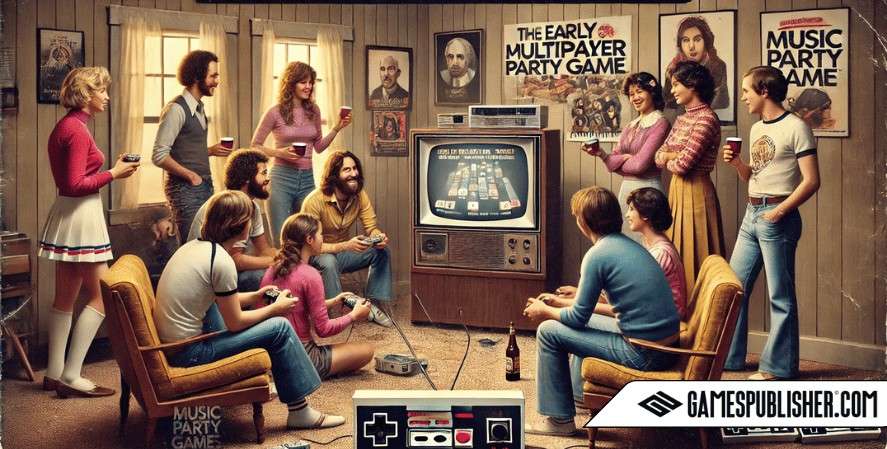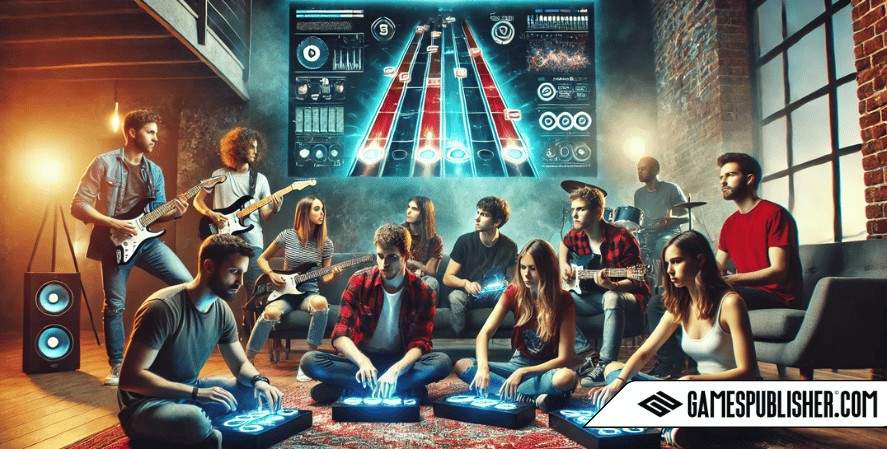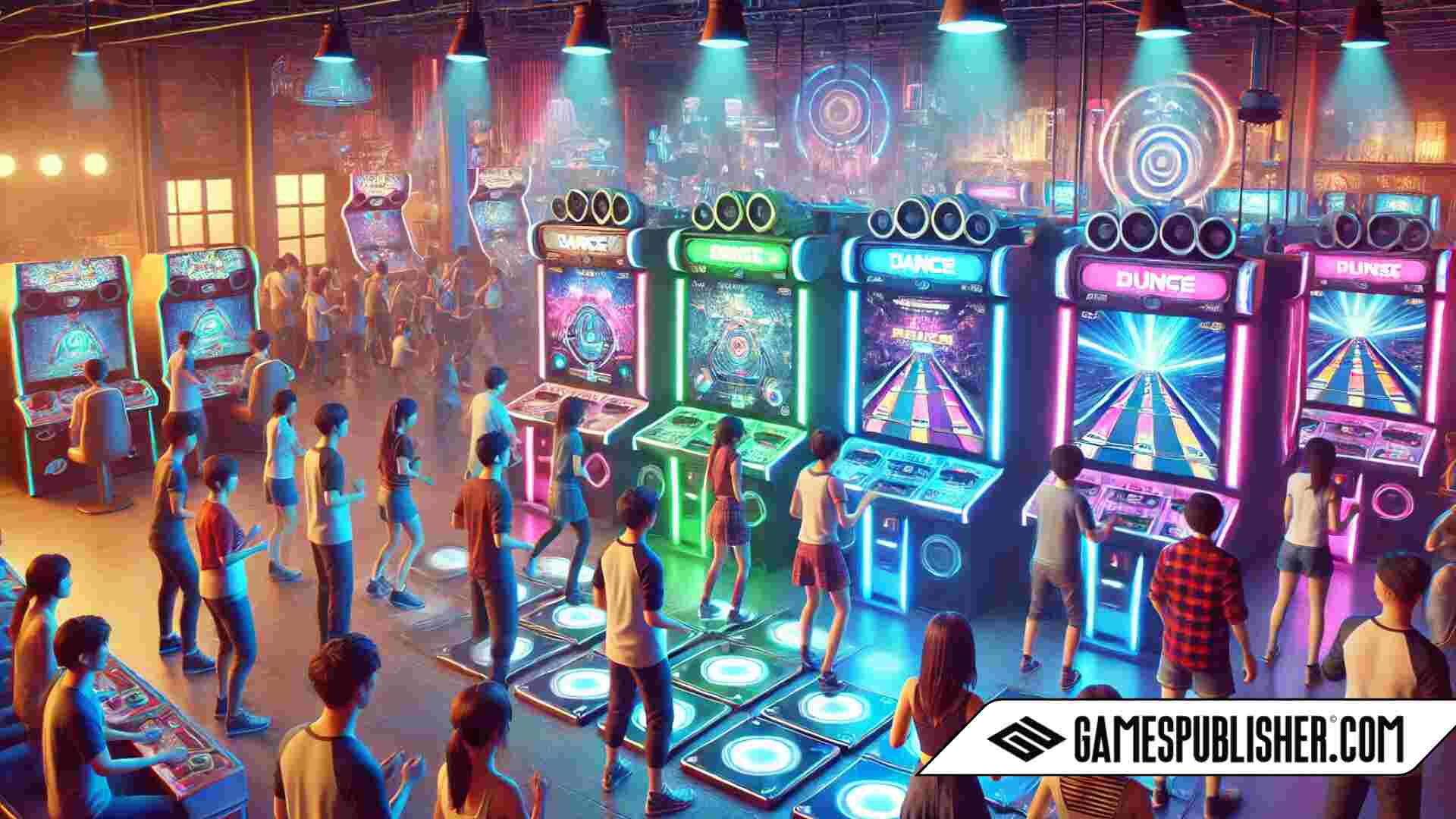The history of party and music games is a fascinating one. These genres have grown alongside video games themselves, evolving from simple beginnings to complex, immersive experiences. Here on Gamespublisher.com, we explore how these games have shaped the gaming industry and influenced both players and developers.
This article dives into the history of party and music games, looking at how these genres became popular and why they remain important. From early arcade machines to modern consoles, party and music games bring people together, making them perfect for social play. Understanding their evolution offers valuable insights for game developers aiming to create engaging, fun games for everyone.
1. The Birth of Party Games

What Are Party Games?
Party games are multiplayer games meant to be enjoyed in groups. They’re easy to learn, so people of all skill levels can play. They often include mini-games or quick rounds, making them perfect for social gatherings. You don’t need a lot of gaming experience to enjoy party games everyone can join in and have fun.
How Party Games Started
Party games have their roots in older forms of entertainment like board games and arcade games. Classic games like Pong (1972) and Space Invaders (1978) were among the first to have multiplayer modes. But it wasn’t until home consoles became popular that party games really took off.
One of the first big multiplayer games was Bomberman, released in 1983. Bomberman allowed several players to compete at once. It set the tone for what would become important in party games: simple controls and quick, fun rounds.
TV game shows like Family Feud also influenced party games. These shows brought people together in competition, creating a fun and lively atmosphere that party games would later try to capture.
Mario Party: The Game That Changed It All
In 1998, Nintendo released Mario Party for the Nintendo 64. This game became a hit and helped define the party game genre. With a game board structure and lots of mini-games, Mario Party was perfect for local multiplayer. People loved playing it at gatherings, and its popularity led to many sequels.
Mario Party also inspired other developers to create similar games. Titles like WarioWare Inc., Super Smash Bros., and Fusion Frenzy followed, adding new ideas to the genre. These games mixed friendly competition with group play, making them favorites for parties and family events.
2. The Rise of Music and Rhythm Games

What Are Music and Rhythm Games?
Rhythm games focus on timing and music. Players follow beats and try to match actions with the rhythm of the song. These games test players’ timing and coordination, rewarding them for staying in sync with the music. Unlike other genres, music and rhythm games rely heavily on soundtracks and musical timing to guide gameplay.
Early Music Games: Konami’s Influence
The rhythm game genre started in the 1990s, thanks to Konami. They created Beatmania in 1997, a game where players had to hit keys in time with music, making them feel like a DJ.
Then, in 1998, they released Dance Dance Revolution (DDR), which became a huge success. DDR used a dance pad, so players had to step on arrows in time with the music. It became popular in arcades and got players moving.
Around the same time, PaRappa the Rapper (1996) was released for consoles. This game combined rhythm mechanics with a fun storyline. It was one of the first rhythm games to tell a story, setting a standard for future games in the genre.
The Guitar Hero and Rock Band Boom
In the mid-2000s, Harmonix Music Systems changed music games again with Guitar Hero (2005). This game let players use a guitar-shaped controller to play along with popular rock songs. Players felt like rock stars, hitting notes in time with the music. Guitar Hero was a massive hit, and soon after, Rock Band (2007) came out, adding drums, bass, and vocals so players could form bands.
These games became incredibly popular. People held parties just to play Guitar Hero or Rock Band, and the games introduced many new fans to music gaming.
The Decline and New Changes in Music Games
By the early 2010s, the popularity of instrument-based music games started to fade. Too many similar games flooded the market, and the cost of the special controllers was high. However, the rhythm game genre didn’t disappear—it changed.
New types of rhythm games, like Beat Saber (2018), used virtual reality (VR) to create a new kind of experience. In Beat Saber, players use VR controllers to slice through blocks to the beat of the music. Mobile rhythm games like Cytus and Deemo also became popular, letting players enjoy music gaming on their phones. These new formats kept rhythm games alive and exciting.
3. How Party and Music Games Shaped Modern Gaming

Social and Multiplayer Gaming
Both party and music games have had a big impact on multiplayer gaming. They bring people together, whether they’re dancing in front of a screen with Just Dance, playing mini-games in Super Mario Party, or hitting notes in Guitar Hero. These games are popular at parties and family gatherings.
Today, many party and music games also include online multiplayer modes. Games like Just Dance and Mario Party Superstars let players connect and play with friends even if they’re far apart. This adds a new level of fun, allowing for both in-person and virtual gatherings.
How These Games Influence Game Development
Party and music games have shown developers that simple, easy-to-learn games can be incredibly popular. Many games now include intuitive controls and user-friendly interfaces inspired by party and music games. Even games outside these genres sometimes add rhythm-based mini-games or party mechanics to make them more engaging.
Music games have also influenced how soundtracks are used in all kinds of games. A great soundtrack can make a game more exciting, and many developers now use music to enhance gameplay.
The Future of Party and Music Games
As technology grows, party and music games are likely to change with it. Virtual reality (VR) and augmented reality (AR) offer new ways for players to interact with games. Games like Beat Saber have already shown how VR can make rhythm games more immersive.
With the rise of mobile gaming and cloud gaming, party games are also becoming easier to access on different platforms. This means that people can play party games or rhythm games wherever they are, whether it’s on a console, PC, or phone. These new technologies could make party and music games even more social and connected.
Conclusion
Party games and music/rhythm games each offer something unique to the gaming world. They focus on fun, social play, and are great at bringing people together. Over the years, these genres have grown, changed, and adapted with new technologies. For game developers, understanding how these games work can be valuable. It shows that simple, accessible games can still create memorable experiences.
Both party and music games prove that games are more than just entertainment they’re ways for people to connect. As these genres continue to evolve, they will likely keep inspiring both developers and players, making sure that the joy of gaming remains something everyone can enjoy.
Loading survey...

